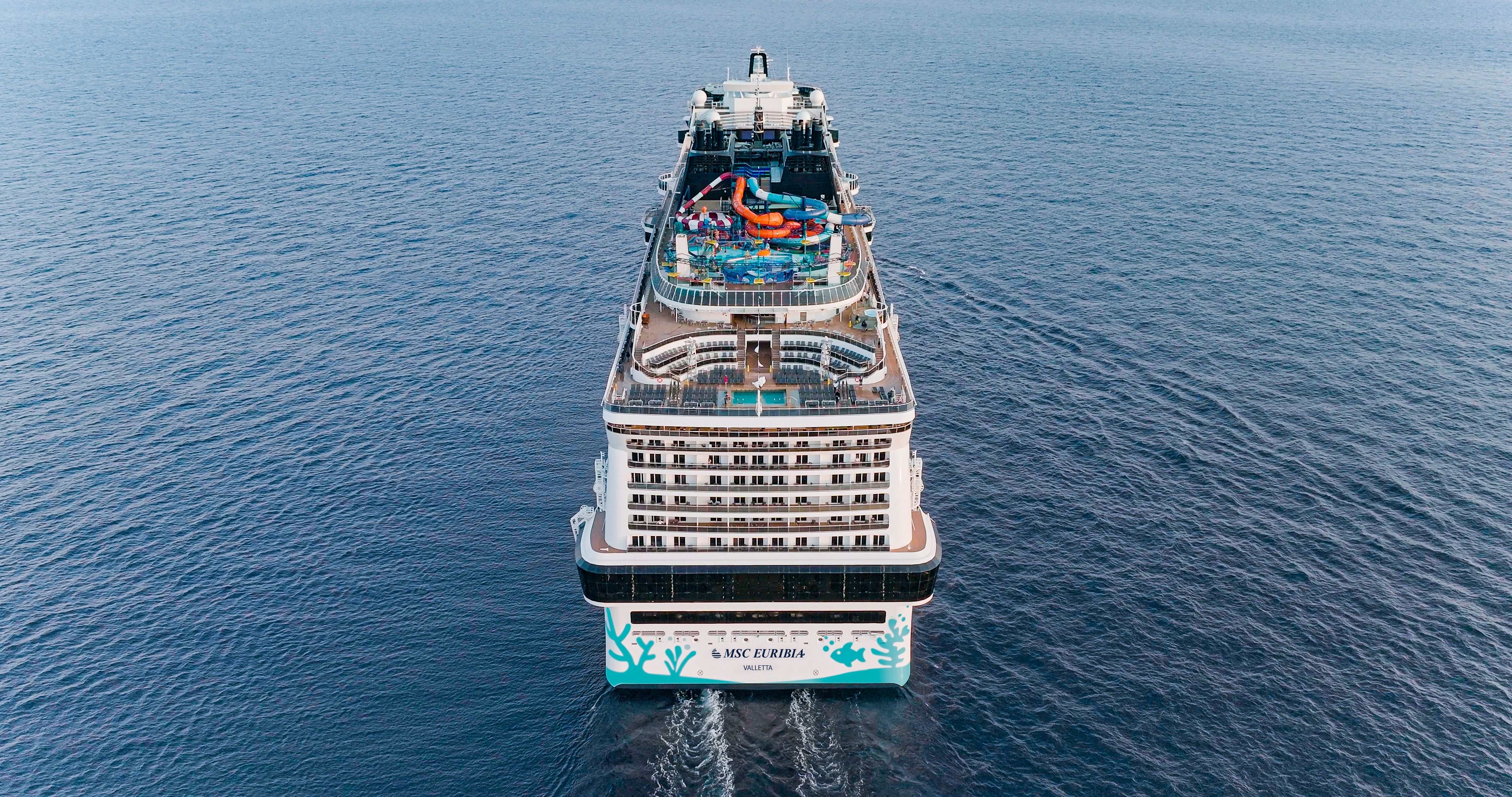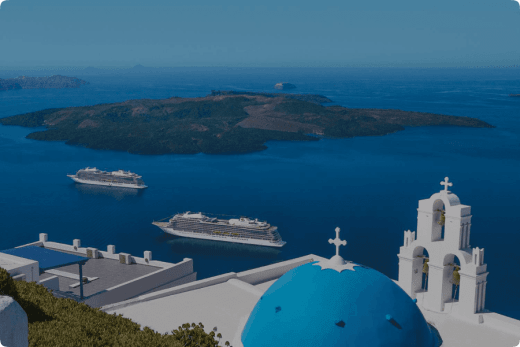Sustainable cruising in 2025: How major lines compare

Why sustainable cruising matters in 2025
There’s no denying it, travelers are more tuned in than ever to the environmental cost of their vacations. As climate awareness rises and low-impact travel options gain traction, many are asking the same question: can cruise vacations actually be eco-friendly?
It’s a fair concern, with many travelers concerned about the environmental impact of cruise ships. But surprisingly, eco-friendly cruises are becoming more of a reality in 2025. Advances in clean energy, waste reduction, and sustainable dining are starting to reshape what sustainable travel by sea really looks like making green cruises a reality. So, are cruises environmentally friendly now? Not all of them, but some are putting in real work to get there.
This article compares 16 major cruise lines and their most meaningful green initiatives—so you can see who’s serious about change and who’s still catching up.
On this page:
- The big picture: Are cruises eco friendly today?
- What makes a cruise ship eco-friendly?
- Cruise line sustainability rankings: Who’s leading in 2025?
- Cruise lines with strong carbon goals and offset programs
- Spotlight on innovation: New cruise ship green tech
- Waste, recycling, and food sustainability at sea
- Sustainable sourcing and onboard dining
- Best eco-friendly cruises by travel style
- How to choose an eco-friendly cruise
Related: 2025’s most anticipated cruise ships
Search eco-friendly sailings:
The big picture: Are cruises eco friendly today?

Cruises are becoming more eco-friendly thanks to cleaner fuel options, shore power, and better waste management. While the industry has a history of high emissions and over-tourism, many cruise lines are making real progress toward sustainability with new technologies and environmental commitments.
But let’s start with the elephant in the room: are cruises bad for the environment? Historically, the cruise industry has earned its reputation for high emissions, waste, and over-tourism. But change is in motion, and green cruise ships are happening faster than many people realize.
In the last few years, new ships have rolled out with cruise ship emissions tech that cuts pollution dramatically. Shore power is gaining ground too — 46% of the global cruise fleet is now equipped to plug in at port, meaning engines can shut off entirely while docked.
While the environmental impact of cruises still varies by line and ship, the pressure to clean up is real, and some cruise lines are leading the charge.
What makes a cruise ship eco-friendly?

A cruise ship is considered eco-friendly when it uses sustainable technologies and practices to reduce its environmental impact. Key features include advanced wastewater treatment systems, energy-efficient engines, shore power capability, reduced single-use plastics, and cleaner fuel alternatives like LNG. Experts and environmental groups prioritize these measures when evaluating a ship's sustainability.
If you're comparing ships, knowing what actually counts as a green feature helps cut through the marketing fluff. Here's what experts and environmental groups tend to prioritize:
LNG fuel vs. scrubbers: Liquefied natural gas (LNG) reduces sulfur oxide emissions by 99%, and it’s being adopted by several major lines. Scrubbers, on the other hand, are older tech that filters emissions but can discharge pollution into the water.
Shore power integration: Ships that can plug into local electric grids at port help cut noise and emissions completely while docked.
Hybrid battery systems and fuel cells: Think of these like the Prius of the sea—designed to supplement traditional engines with cleaner tech.
Advanced wastewater treatment: Some new ships treat wastewater to near-drinkable levels before discharge. Cruise ships with advanced wastewater treatment are becoming more common, especially among newer vessels.
Zero waste initiatives and recycling: Lines like Virgin Voyages and Disney have taken strong stances on onboard recycling and no-plastic policies, earning praise from environmental groups.
Food waste reduction tech: Biodegradable digesters, AI kitchen sensors, and smarter buffet design all play a role in cutting food waste.
Sustainable sourcing: Sustainable seafood cruises and menus with local, in-season ingredients are gaining traction across the industry.
If you’re comparing cruise lines with no plastic, LNG cruise ships, or hybrid cruise ships, these features are the ones to keep an eye out for.
Cruise line sustainability rankings: Who’s leading in 2025?

In 2025, cruise line sustainability rankings show significant differences in commitment across major brands. Top performers stand out for their emissions transparency, energy-efficient upgrades, advanced waste management systems, and responsible food sourcing. Across the 16 major cruise lines we reviewed, some lines are clearly ahead of the pack while others still have some catching up to do.
At the top, a few brands stand out. Disney Cruise Line continues to impress with LNG-powered ships, no scrubber use, and some of the best cruise line sustainability rankings in the industry. Virgin Voyages earns points for banning single-use plastics and offsetting 100% of emissions. Royal Caribbean which includes Celebrity Cruises combines LNG and fuel cell investments with strong partnerships like WWF.
MSC Cruises was one of the first to set carbon neutral cruises as a goal. Their efforts now include hydrogen fuel R&D and next-gen recycling systems.
In the middle tier, lines like Norwegian Cruise Line, Cunard Line, Holland America, Princess Cruises, Costa Cruises, and Viking Ocean Cruises show steady progress with some more vocal about it than others.
At the lower end of the sustainability curve, Carnival Cruise Line, Seabourn Cruise Line, Regent Seven Seas Cruises, Azamara Cruises, and Oceania Cruises show slower progress, with limited public sustainability goals and continued reliance on older technologies.That said, each of these lines has sustainability efforts underway. Carnival is testing biofuels and improving food sourcing, Seabourn and Regent are investing in wastewater treatment and waste reduction, Azamara is upgrading propulsion systems, and Oceania has launched “Go Green” tours and expanded shore power capabilities.
So who holds the title of most eco friendly cruise line? There’s no single answer, but if you’re looking to book with confidence, start with those in the top tier of the cruise lines with best environmental record.
Cruise lines with strong carbon goals and offset programs

Who’s aiming for Net Zero and who’s just talking the talk?
Several cruise lines have publicly committed to Net Zero targets by 2050 or sooner. MSC, Virgin, Viking, and Celebrity are among those with specific plans to push green cruising.
Some cruise lines now run voyages that offset carbon entirely. Virgin has committed to making all direct emissions from its flagship Scarlet Lady carbon neutral through verified carbon offsets. Norwegian is offsetting three million metric tonnes of greenhouse gas emissions over three years as part of its path to carbon neutrality. MSC also achieved a net-zero emissions sailing with MSC Euribia during a special four-day voyage in 2023, demonstrating the potential for carbon-neutral cruising at scale.
Some lines now run cruises that offset carbon entirely. Others, like Costa, RCI, and Princess, offer optional offset purchases during booking.
That being said, not all offsets are equal. Travelers should ask where credits are going, how they’re measured, and whether they complement actual emissions cuts.
If you’re focused on carbon neutral cruises or searching for sustainable luxury cruises, it’s important to separate real efforts from feel-good fluff.
Spotlight on innovation: New cruise ship green tech
![]()
What’s powering the shift? A mix of impressive upgrades across new builds and retrofits.
Several major cruise lines have introduced LNG-powered ships as part of their push toward more sustainable operations. Carnival has launched three LNG-powered vessels: Mardi Gras, Carnival Celebration, and Carnival Jubilee. MSC entered the LNG space with MSC World Europa, followed by MSC Euribia, and plans to launch MSC World America. Disney debuted its first LNG ship, Disney Wish, followed by Disney Treasure, with Disney Destiny set to join the fleet in 2025. Costa Cruises was an early adopter, introducing Costa Smeralda, and Costa Toscana. These ships reflect each brand’s investment in cleaner fuel alternatives to reduce emissions and improve environmental performance. LNG is cleaner than traditional marine diesel, slashing emissions significantly.
Meanwhile, Viking is testing hydrogen fuel cell cruise ships, starting with the Viking Neptune, while Princess has similar tech in its Sphere-class ships.
Royal Caribbean is piloting waste to energy cruise ship systems on newer vessels like Icon of the Seas, and HAL is testing biofuel blends to reduce its carbon load. Battery-assisted hybrid systems are also being explored by lines like NCL and Seabourn.
Don’t overlook infrastructure, either—Royal Caribbean’s LEED Zero Energy terminal in Miami is one of the first of its kind, fully powered by renewables.
Join green tech cruises for a sustainable journey:
Waste management, recycling, and food sustainability at sea

Cruise ships go through a lot of food and packaging. Some lines are starting to turn that around with smarter systems and more thoughtful design.
Virgin Voyages’ no-buffet model has led to a 60% drop in food waste. Costa’s 4GOODFOOD program has reduced food waste by 42%, thanks to tech and staff training.
Disney takes recycling seriously, diverting more than 6,400 tons of waste each year. HAL and Princess use biodigesters and donate excess food at select ports.
If you're looking for a zero waste cruise or comparing cruise lines with recycling programs, these are meaningful distinctions. Cruise food waste reduction efforts can also tell you a lot about a brand’s values.
Sail with cruise lines dedicated to waste and food sustainability:
Sustainable sourcing and onboard dining

Food can be a major footprint and some cruise lines are getting smarter about it.
The Royal Caribbean Group, HAL, and Disney have adopted verified sustainable seafood cruises sourcing policies. Disney also leads in ethical food practices, including cage-free eggs and humane treatment certifications.
Lines like Azamara, Oceania, and Seabourn lean into local sourcing by buying regional produce and seafood while in port. Regent’s higher-end ingredients often meet strict sustainability standards too.
If you care about cruise line food sourcing sustainability or want to try farm-to-table cruises, these distinctions are worth noting.
Book your sustainable dining experience:
Best eco-friendly cruises by travel style
Different travelers look for different things, but some patterns are clear.
For families, brands like Disney, Princess, and Virgin are standouts. They combine no-plastic policies with educational shore excursions and kid-friendly conservation programs, perfect for cruises for eco-conscious travelers.
Check out family-friendly sustainable cruise lines:
Luxury-focused travelers may gravitate toward Regent, Seabourn, or Oceania. Their quiet propulsion systems, sustainable sourcing, and thoughtful design choices align well with sustainable luxury cruises.
Discover luxury sustainable cruise lines:
Younger and savvy adults who prioritize meaningful experiences and new tech will find solid options in Virgin Voyages, Celebrity, and NCL. These lines are investing in innovation and more culturally aware travel, making them top picks among green cruise lines.
Explore sustainable, tech-forward cruise lines for adults:
How to choose an eco-friendly cruise

To choose an eco-friendly cruise, look for ships that run on cleaner fuels like LNG or biofuels, are equipped for shore power, and have advanced waste treatment systems. Ask if the cruise line offers carbon offset programs and whether they collaborate with environmental organizations. These factors help identify operators that go beyond marketing claims and make real efforts to reduce their environmental impact.
If you’re ready to book, here are five smart questions to ask first:
- What kind of fuel does the ship use?
- Is it shore-power capable?
- What happens to waste onboard?
- Are carbon offsets included—or optional?
- Does the line partner with any environmental organizations?
If you're searching for the best cruise for responsible travel or reviewing environmentally friendly cruise ships, those questions are a strong place to begin.
A greener horizon for ocean cruising
Cruise lines aren’t perfect, but a lot of them are making real progress. If sustainability matters to you, choosing a cruise line that shares those values can make a difference. Every booking is a small step toward moving the industry in the right direction.
Start exploring eco-conscious sailings and book your next greener getaway at Cruisebound.


